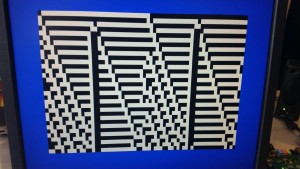Some takeaways from our final design:
- Automation worked beautifully 1
- So did the rotation of the automation 2
- The audio implementation did not work when we scaled our design up from 16×16 to 64×32 which was disheartening. We were able to demonstrate that we could play four notes at once, but reading and analyzing the data from the BRAM was not functional.
- Teamwork went well
This design was a spin off of an already designed system. We really wanted to show the computational power of cellular automata, and we felt that using audio would be a fun way to describe this. While the audio generation was not ultimately successful, just being able to show the automata themselves shows how drastically different the results of changing one bit in the rule state can be.
Looking back on the finished product, we should have stuck with a 16×16 display for our final design. We had nearly full functionality with about a week and a half to go. Scaling up the design posed many timing and memory issues that we didn’t foresee before making the decision to scale up. Even though the finished design looked much better, our overall project goal would have been easily accomplished more if we kept the scale of the automation at a reasonable level.
Parts – None needed to be bought by outside vendors
- Zedboard
- Monitor
- VGA Cable
- Pmod Amplifiers
Tasks
- Danny
- Automation calculations
- Website maintenence
- Integration
- Sarah
- BRAM Configuration
- VGA output
- Pmod Output
- Integration
Code
[gview file=”http://elec444sp15ec3a.blogs.bucknell.edu/files/2015/04/Code.zip”]

